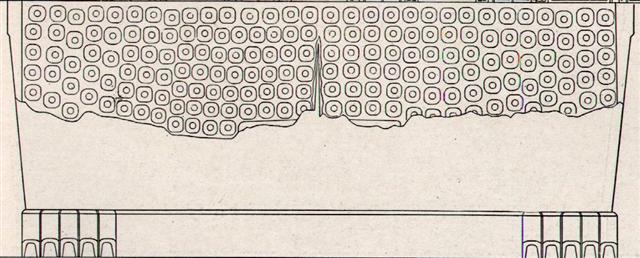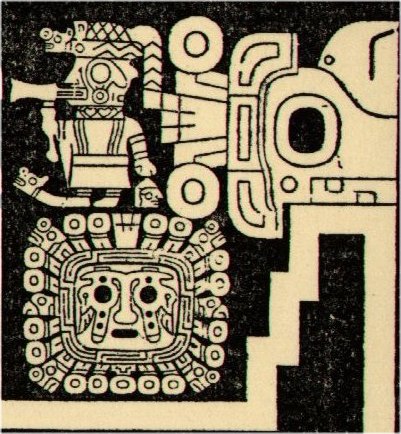365 at Hanga Te Pau cannot mean days from a new year at
midwinter, because we have earlier found the beginning of the 4th
quarter at Gb5-1:
|
2nd half year |
 |
116 |
 |
 |
10 |
 |
106 |
|
Gb1-7 |
Gb4-33 |
Gb5-1 |
Gb5-12 |
|
236 |
353 |
354 |
365 |
|
3rd quarter |
4th quarter |
The journey of the
sun begins at Ga1-1 and reaches its end with 6 * 59
= 354 glyphs. After
resting for 10 glyphs he is completely finished (pau),
because 364 = 13 * 28.
This description
agrees with how the kuhane of Hau
Maka arrived at the beginning of the 4th
quarter. Sun leaves and the dream soul enters.
Manuscript E
locates Hanga Te Pau indirectly to He Maro,
by letting the canoe of Ira touch ground
there on the first day of that month (i te raa po
rae o te maro, p. 17), a fact which can be
accepted only if He Maro once meant that the
last month of the sun journey ended with the 3rd
quarter. A calendar with 12 solar months probably is
a late development, invented after the arrival of
Ira and his team of explorers.
|
|
The famous Pachamama statue in Bolivia is designed with 177
sun symbols in her skirt:

(Ref. Posnansky)
Although Posnansky
argued for 94 + 88 = 182 double
circles once having been visible, meaning 2 * 182 = 364 days in
a year, I do not agree. Her right leg (left from us seen) is in the
north, meaning close to the sun, while her left leg has fewer sun
symbols. So much is clear.
But it is only the
summer half of the year we see, not the whole year. Spring equinox
is at left (from us seen), and then sun moves further south until
reaching summer
solstice (represented by the division between her legs (quarters).
The number of sun symbols intensifies up to solstice, then slowly
diminishes again, reaching the end of summer at the extreme right
with autumn equinox.
Counting should
not be done horizontally (as Posnansky has tried) - that would be
like counting together apples and bananas. It should be done vertically:
|
left leg
from us seen |
|
columns 1-5 |
columns 6-8 |
columns 9-12 |
columns 13-15 |
|
5 * 5 = 25 |
3 * 6 = 18 |
4 * 7 = 28 |
23 |
|
94 |
|
right leg
from us seen (reversed) |
|
columns 9-15 |
columns 1-8 |
|
7 * 5 = 35 |
8 * 6 = 48 |
|
83 |
94 + 83 = 177 days
for the summer is not a bad measure because summer is shorter than
winter south of the equator. 177 = 3 * 59, equal to half of a year
defined as 6 * 59 = 354 days. A double circle is like one eye of the
sun - the pupil is the smaller circle. |
Posnansky has tried to include 5 more sun signs at right in the picture. The left side of the skirt is irregular, and we therefore cannot expect a symmetry between the two sides. Beyond summer solstice (right in the picture) there should be fewer sun signs and also a shorter skirt. It would be wrong to prolong the skirt with 5 more signs.
His calendar at the top of the picture must be wrong. The middle is not defined by spring equinox (September). The middle is in late December (summer solstice).
The twice 5 toes are located at the equinoxes and the legs are defined by summer solstice and equinoxes. Above the 5 toes following spring equinox (left in the picture) there are 5 * 5 sun signs. Above the 5 toes before autumn equinox (right in the picture) there are also 5 * 5 sun signs. Yet, also the preceding two columns have 5 sun signs each.
Adding 5 * 5 (left) + 7 * 5 (right) = 12 * 5 = 60. 177 - 60 = 117 = 9 * 13.
Summer has 30 columns and the central of them (30 - 12 = 18) have 9 * 13 sun signs (117 days), while the peripheral columns have 5 * 12 sun signs (60 days):
| early summer |
5 * 5 |
25 |
| high summer |
9 * 13 |
117 |
| late summer |
7 * 5 |
35 |
| summer |
12 * 5 + 13 * 9 |
177 |
5 * 5 ('fire-fire') is a reasonable sign for increasing heat. 7 * 5 will then describe a 'fire' slowly fading away.
Central 9 * 13 is doubly ominous. At high summer the great 'fire' must be stopped or the whole world will take fire.

In the Gateway of the Sun the head has been cut off.



.jpg)
